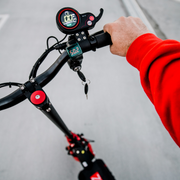Lithium-ion batteries are the go-to power source for nearly all electric mobility devices. These rechargeable and lightweight batteries offer immense power output for their weight, boasting longer life cycles and faster charging times than heavier sealed lead-acid batteries.
However, lithium-ion batteries are not indestructible, and understanding the intricacies of these complex batteries is essential for getting reliable performance from your device.
A typical battery pack has a lifespan of 300 to 500 cycles on average. This is approximately one to three years or 6,000 to 20,000 kilometres depending on the battery’s voltage and capacity.
But, this does not necessarily mean that you must replace your battery after 300 to 500 cycles; it simply means that its capacity will decrease, resulting in decreased device performance.
The exact lifespan of your battery will be determined by several factors, such as battery voltage, capacity, Amp hours, how and where you ride, and your weight.
The capacity of a battery is the amount of energy it can store, which is critical. The larger the capacity, the longer the battery should last.
Most electric mobility manufacturers prefer to use a lithium battery because they hold their charge for a long time. However, this does make them more expensive. But keep in mind if you buy a cheaper device with a smaller cheaper battery, you won’t get the range or power you expect.
To determine how far your electric mobility device can travel on a full charge, you cannot rely solely on the manufacturer's range guide. Factors such as terrain, riding style, weight, and the make and size of your battery will determine your device's true range, which may require several trips to estimate accurately.
Whether your battery is brand new or has already exceeded 500 cycles, taking proper care of it will help you get the most out of your e-scooter.
So let's plug in.
Know your battery type and specifications
Lithium-ion batteries may be the most common type of battery. However, not all devices use them. This means not all chargers are compatible with all batteries. Only use the manufacturer’s recommended charger.
Keep the battery charged at all times
The most effective way to keep your battery healthy is to charge it after each use. Even if your battery still has a lot of charge left after a full day of traveling, make it a point to charge it at the end of the day. This will reduce the strain on your battery and keep it in good working order.
Plus, your battery will always be charged and ready to go when you need to get moving.
Another way to extend the life of your battery is to never fully drain it. Although completely draining and then fully charging a battery may be effective for some devices, it will not work for electric scooter batteries.
If riding a scooter. Try to avoid riding up steep hills as fast as you can in the fastest speed mode. This will strain your battery and cause it to heat up and drain faster.
Luckily with electric bikes, hills can be tackled with ease. By assisting the bike up the hill can take a massive load off the battery. So remember to keep up the revs with your peddling and your battery will happily work away.
If you're thinking about going on holidays and will be leaving your battery for a while. Don't leave it with an almost-empty battery. Check that it has a charge of at least 40-50 percent. If you have time, fully charge your battery before storing your device for an extended period.
Lithium batteries last longer when they have stored charge, so charge your battery at least once every 30 days. This is especially important if the battery is not used frequently or for long periods.
Use the correct charger
We can’t stress this enough. Although it may appear obvious, you have to use the correct e-scooter charger for your specific device. You will wreak havoc on your battery if you use an incorrect or damaged battery charger.
You might think you’re saving money by not purchasing the premium charger, but actually, the damage a knock off charger will cause to the battery will be more expensive than the charger you didn’t want to fork out for.
Purchasing the proper charger in the first place is much less expensive than purchasing an aftermarket charging cable and then replacing the entire battery. If you require a charger, contact the manufacturer, or the company from who you purchased your e-scooter and request the original charger specifically designed for your electric scooter.
Electric vehicle chargers are complicated. They have special safeguards in place to prevent battery damage. To avoid overheating, they charge slowly. They can also get very hot to the touch. This is normal for a lot of chargers.
Most chargers have a built-in heat dispersing system using aluminium plates. So, keep them out in the open and uncovered for them to disperse that heat. To put it simply: respect your battery and make sure it has the correct charger.
If you have a Zero e-scooter and need a Zero charger, you can find it on our website.
Keep your battery at the Ideal temperature
Do not leave electric scooters outside in extreme weather; extremely high or low temperatures stress the batteries. Lithium batteries perform best at optimal temperatures ranging from 0 to 45 °C. Excessive temperatures, either below 0 °C or above 45 °C can affect the performance and life span of the battery.
Leaving the electric mobility devices outside in either hot or cold weather can cause damage and reduce the life of the battery. It is best to keep your battery in a safe place where temperatures don’t fluctuate too much.
The battery could swell, and liquid could leak. In the worst-case scenario, the cells can deform, and the electrolyte can freeze, causing the cells to short circuit and the battery to explode.

Don’t overload your device with too much weight
All manufacturers conduct a load test and recommends the maximum load capacity of their device. It varies by type and model, but in general, electric scooters have a carrying capacity ranging from 60 to 200 kg. Electric bikes have a carrying capacity ranging from 80 to 150 kg.
Overloading your mobility device will eventually damage the battery and controller. Stick to the recommended load, or buy a mobility device designed for heavier riders.
Think smooth ride
When riding an electric vehicle, keep in mind that you are not riding a gasoline vehicle; sudden acceleration puts strain on the battery. To accelerate, gradually increase your speed for a smooth and enjoyable ride.
Avoid overcharging the battery
While it is critical to charge your battery on a regular basis, it is also critical not to overcharge it. Once fully charged, remove it from the plug or cable immediately.
If your battery begins to take longer to charge than usual, it is most likely nearing the end of its life and needs to be replaced. When this occurs, it is time to replace your battery.
Knowing the warning signs
Damaged batteries and chargers can be hard to detect. But don’t stress! Batteries and chargers can be tested. Monitoring your battery voltage regularly will also give you a good idea of how happy your battery is.
Here are 5 things to look out for
- An overpowering sour smell (Similar to a felt pen). This can be a sign of a battery cell that has vented and leaked out some of its electrolytes. Make sure to place the battery or device in a safe open area and contact the manufacturer and/or service shop for advice.
- Check you have the right charger for your device. This is of high importance. Check that the voltage output of the charger matches the max voltage of your battery. If you are unsure, please contact the manufacturer and/or service shop for advice.
- A burning smell from the battery or charger. This can be a sign of a short circuit. Charging ports can sometimes get water and other foreign particles stuck inside them. This can also be a sign that a fuse has failed. Make sure to place the battery or device in a safe open area and contact the manufacturer and/or service shop for advice.
- The battery will not achieve its full voltage. This can be a charger that is no longer able to charge the full amount. This can also be a sign of a battery starting to lose its voltage and capacity. Best to get the battery load and charge tested to know how the battery is performing.
- If the battery and/or device has been exposed to a lot of water. Make sure to place the battery or device in a safe open area and contact the manufacturer and/or service shop for advice. Most batteries are sealed well, but water ingress is a very common issue. Try to limit the amount of riding on wet ground and in rain. Do not wash with high pressure water. If your device has been submerged. Do not attempt to turn on or charge the battery. Seek advice.
If you are experiencing power issues with your device, you can try the flow chart below. If you are unsure in any way, please seek advice before attempting the chart.








